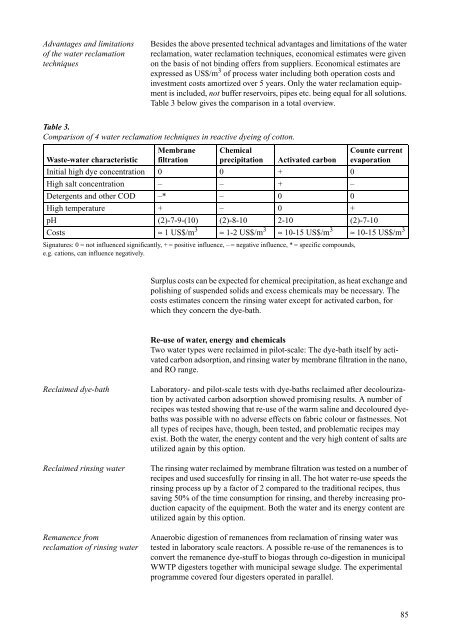Cleaner Technology Transfer to the Polish Textile ... - Miljøstyrelsen
Cleaner Technology Transfer to the Polish Textile ... - Miljøstyrelsen
Cleaner Technology Transfer to the Polish Textile ... - Miljøstyrelsen
You also want an ePaper? Increase the reach of your titles
YUMPU automatically turns print PDFs into web optimized ePapers that Google loves.
Advantages and limitations<br />
of <strong>the</strong> water reclamation<br />
techniques<br />
Besides <strong>the</strong> above presented technical advantages and limitations of <strong>the</strong> water<br />
reclamation, water reclamation techniques, economical estimates were given<br />
on <strong>the</strong> basis of not binding offers from suppliers. Economical estimates are<br />
expressed as US$/m 3 of process water including both operation costs and<br />
investment costs amortized over 5 years. Only <strong>the</strong> water reclamation equipment<br />
is included, not buffer reservoirs, pipes etc. being equal for all solutions.<br />
Table 3 below gives <strong>the</strong> comparison in a <strong>to</strong>tal overview.<br />
Table 3.<br />
Comparison of 4 water reclamation techniques in reactive dyeing of cot<strong>to</strong>n.<br />
Membrane Chemical<br />
Counte current<br />
Waste-water characteristic filtration precipitation Activated carbon evaporation<br />
Initial high dye concentration 0 0 + 0<br />
High salt concentration – – + –<br />
Detergents and o<strong>the</strong>r COD –* – 0 0<br />
High temperature + – 0 +<br />
pH (2)-7-9-(10) (2)-8-10 2-10 (2)-7-10<br />
Costs ≈ 1 US$/m<br />
Signatures: 0 = not influenced significantly, + = positive influence, – = negative influence, * = specific compounds,<br />
e.g. cations, can influence negatively.<br />
3<br />
≈ 1-2 US$/m 3<br />
≈ 10-15 US$/m 3<br />
≈ 10-15 US$/m 3<br />
Surplus costs can be expected for chemical precipitation, as heat exchange and<br />
polishing of suspended solids and excess chemicals may be necessary. The<br />
costs estimates concern <strong>the</strong> rinsing water except for activated carbon, for<br />
which <strong>the</strong>y concern <strong>the</strong> dye-bath.<br />
Re-use of water, energy and chemicals<br />
Two water types were reclaimed in pilot-scale: The dye-bath itself by activated<br />
carbon adsorption, and rinsing water by membrane filtration in <strong>the</strong> nano,<br />
and RO range.<br />
Reclaimed dye-bath Labora<strong>to</strong>ry- and pilot-scale tests with dye-baths reclaimed after decolourization<br />
by activated carbon adsorption showed promising results. A number of<br />
recipes was tested showing that re-use of <strong>the</strong> warm saline and decoloured dyebaths<br />
was possible with no adverse effects on fabric colour or fastnesses. Not<br />
all types of recipes have, though, been tested, and problematic recipes may<br />
exist. Both <strong>the</strong> water, <strong>the</strong> energy content and <strong>the</strong> very high content of salts are<br />
utilized again by this option.<br />
Reclaimed rinsing water The rinsing water reclaimed by membrane filtration was tested on a number of<br />
recipes and used succesfully for rinsing in all. The hot water re-use speeds <strong>the</strong><br />
rinsing process up by a fac<strong>to</strong>r of 2 compared <strong>to</strong> <strong>the</strong> traditional recipes, thus<br />
saving 50% of <strong>the</strong> time consumption for rinsing, and <strong>the</strong>reby increasing production<br />
capacity of <strong>the</strong> equipment. Both <strong>the</strong> water and its energy content are<br />
utilized again by this option.<br />
Remanence from<br />
reclamation of rinsing water<br />
Anaerobic digestion of remanences from reclamation of rinsing water was<br />
tested in labora<strong>to</strong>ry scale reac<strong>to</strong>rs. A possible re-use of <strong>the</strong> remanences is <strong>to</strong><br />
convert <strong>the</strong> remanence dye-stuff <strong>to</strong> biogas through co-digestion in municipal<br />
WWTP digesters <strong>to</strong>ge<strong>the</strong>r with municipal sewage sludge. The experimental<br />
programme covered four digesters operated in parallel.<br />
85

















